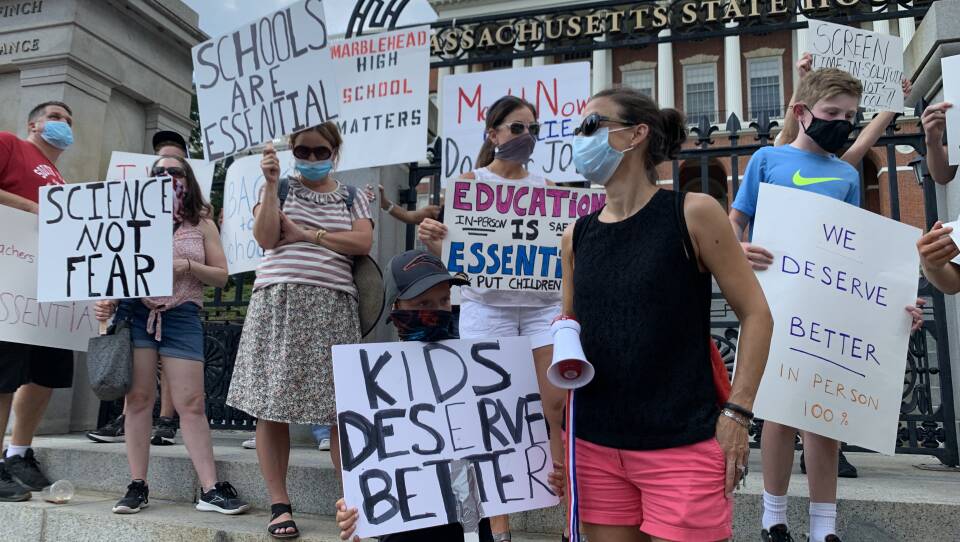A group of parents and students rallied outside the Massachusetts State House Wednesday afternoon, ringing bells and holding signs that read “Kids Deserve Better” and “Technology Is Not A Teacher.”
“Our children are being left behind, the time for us to act is now, for our children,” Westwood mother and organizer Antigone Grasso said, flanked by dozens of protesters from the grassroots group, Bring Kids Back MA. “We are calling upon Gov. Charlie Baker and [the Department of Elementary and Secondary Education] to issue a transparent, metric based approach to guide the reasonable reopening of local school systems for in-person learning.”
The protest comes after DESE sent a letter Tuesday to Massachusetts school superintendents, offering a directive on how a new color-coded map detailing infection rates town by town should play a role in their reopening decisions.
“It came a little bit too late,” Grasso said on the steps of the State House. “Baker needs to come out and be very, very clear about when schools should move through different learning models. Otherwise, we are going to be in this process for many, many months, and it's going to affect our children.”
Charley Sesselman, an eight-year-old student at Martha Jones School in her hometown of Westwood, stood beside Grasso holding a sign that read “Kids First.”
Sesselman said she’s had enough of remote learning, which is more difficult than in-person learning and more socially challenging.
“You can't learn with a teacher. You have to get on calls at certain times,” Sesselman said. “And you just feel like you're missing out right now.”
Sesselman and Grasso were joined by a few other parents from Westwood, which has had a total of five COVID-19 cases in the past fourteen days, marking it solidly in the “green” or safe category of the new DESE map.
“If the majority of the districts are green and white, according to Baker's math from yesterday, then when would we go back in person, if we don't go now?" Grasso asked.
Grasso and other activists said if coronavirus cases continue to increase, children could then be placed in a remote-only model, but only after the in-person method is given a chance. For teachers who are concerned about safety, protests urged that there’s a safe way to return in person.
“We love teachers, and we want what's best for the teachers,” Grasso’s husband, Richard Grasso, said. “The teachers belong in school, as do kids. Let's make it happen.”
Protester Nicholas Fusaro, who lives in Boston, argued that teachers can be replaced.
"If the teachers don't feel safe, tell them to stay home and replace them,” Fusaro said. “It's about time the kids get back to school. People need to make a living out there. Enough is enough.”
In another part of the park, Brookline resident Drew Smith watched his three-year-old daughter Keziah play on the Boston Common playground. Smith says even though his neighborhood is on the lower end when it comes to coronavirus case numbers, he still feels unsure about allowing his daughter back to school, which has already opened.
“It's not safe right now," Smith said, "Though I understand that some parents have to work, they are doctors or EMTs, and I understand that it’s difficult to find someone to watch your child.”
Smith, who is currently unemployed due to the pandemic, says child care needs could still be better solved by another solution.
“If you could have somebody watch your kid for the time being, that's probably what's best, and just not send your child back," Smith said. “You would put your kid at risk, especially now.”
Cesar Romero, another father at the park, says he works full-time and still feels uneasy about allowing his four-year-old daughter Valerie to return to school in-person.
“With what's going on, I'd prefer to stay at home with her and not to put her at risk,” Romero said. “Children are too young to handle things like this, you can put so many innocent lives at risk.”
Romero lives in Chelsea, which falls into the “red” category on Baker’s map, with 95 cases recorded over the past two weeks. Chelsea has consistently had the highest concentration of COVID-19 cases in the state since the the pandemic hit the densely-populated community, which is home to many frontline and essential workers.
Romero works nights at a warehouse and watches Valerie while his wife works as a cook during the day. Though he says the situation isn’t ideal, he doesn’t feel safe allowing his child to go to school in-person unless health metrics drastically change.
“It's very hard, but, you know, that's what parents do,” Romero said. “Mom takes care of her when I’m working, and I take care of her when she’s working. We support each other, and that’s why we’re a family.”





